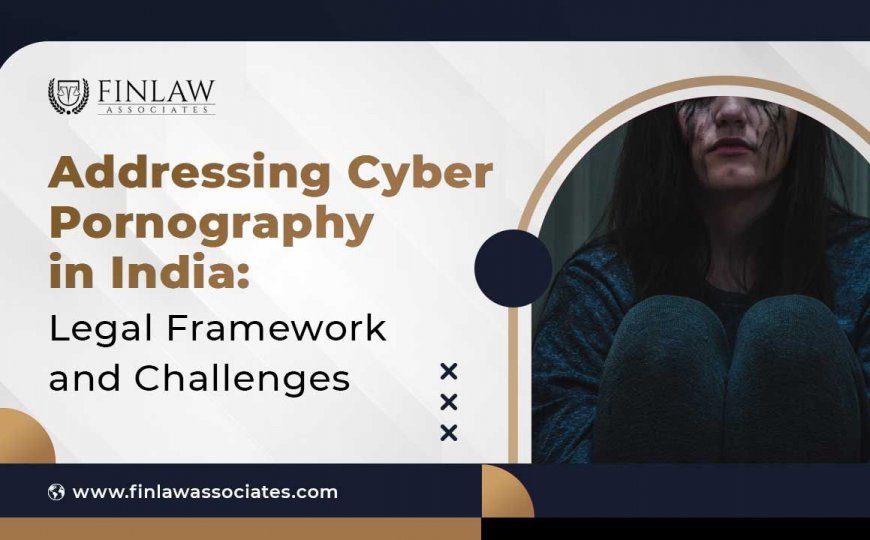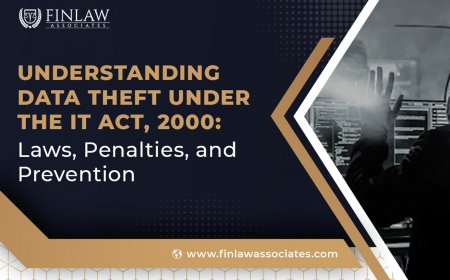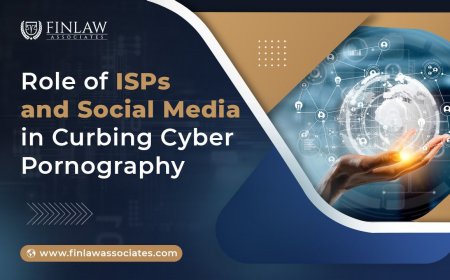Addressing Cyber Pornography in India: Legal Framework and Challenges
Explore cyber pornography in India, its legal framework, challenges, and solutions, focusing on laws, enforcement, jurisdiction, public awareness, and victim support.

India is facing a serious and expanding problem with cyber pornography, which is a reflection of the difficulties worldwide in policing and restricting explicit content on the internet. Cyber pornography has grown more widely available due to the internet's and digital technologies' fast growth, which has sparked worries about its potential effects on society—particularly on minors and vulnerable groups. The problem is multifaceted, including technological, ethical, and legal aspects. This article explores India's legislative framework regarding cyber pornography, the difficulties in implementing these laws, and possible solutions to this widespread issue.
India's Legal Framework Controlling Cyber Pornography
India possesses an extensive legislative structure aimed at combating cybercrime, encompassing cyber pornography. The principal laws that control this field are as follows:
The IT Act, or the Information Technology Act, 2000
The main piece of legislation addressing cybercrimes, including cyberpornography, is the IT Act. The IT Act's Section 67 addresses the particular publishing and transmission of pornographic content via electronic means. According to this section, there is a three-year jail sentence and a fine of up to five lakh rupees for anyone who publishes, transmits, or causes to be published or transmitted in electronic form any material that is lewd or appeals to the sexual interest.
The Indian Penal Code (IPC), 1860
The IPC, which was created before the internet age, has been modified to include provisions for offenses involving cyber pornography. The Indian Penal Code's Sections 292, 293, and 294 make it illegal to sell, distribute, or display pornographic materials. Despite being initially intended to include print and other conventional media, digital material has been considered to fall within these areas.
Protection of Children from Sexual Offences (POCSO) Act, 2012
One important element of the law that specifically handles child pornography is POCSO. The POCSO's Section 14 makes it illegal to utilize minors for pornographic purposes, including keeping child pornographic materials. The production, distribution, and possession of child pornography are all crimes covered by strict prohibitions in this legislation.
The Indecent Representation of Women (Prohibition) Act,1986
Originally intended to address the inappropriate portrayal of women in print and visual media, this legislation has been modified to include internet material. Publication and transmission of any content that portrays women obscenely or disparagingly are forbidden by law.
India's Difficulties in Combating Cyberpornography
Even with a strong judicial system in place, dealing with cyberpornography in India is difficult. Among the principal difficulties are:
Anonymity and Pseudonymity: Because the internet is anonymous, it is challenging for law authorities to find the people who are distributing cyberpornography. Pseudonyms and IP-masked technology such as VPNs are two ways in which people might conceal their identity. This anonymity makes it extremely difficult to identify and bring charges against perpetrators.
Issues of Jurisdiction: The content of cyberpornography is frequently from outside of India, thus it is a worldwide problem. When the content is hosted on servers situated in nations with disparate legal systems, jurisdictional issues might develop. To combat these cross-border crimes, international collaboration is needed, but it is frequently sluggish and riddled with diplomatic pitfalls.
The Changing Character of Technology: Legal systems, which are sometimes sluggish to adjust, face a constant challenge from the quick speed at which technology is developing. Pornographic content is often shared via new platforms and technology like encrypted messaging applications and the dark web, making it challenging for authorities to find and intercept such information.
Insufficient Resources and Enforcement: India's law enforcement authorities frequently lack the technological know-how and resources needed to successfully tackle cyberpornography. Digital forensics and cyber investigations need specific expertise, and the cybercrime sections are frequently underfunded. In addition, the backlog of cases in the judicial system causes delays in prosecution and justice.
Juggling Censorship and Free Speech: Finding a balance between the need to safeguard society from harmful information and the right to free expression is one of the major issues in regulating cyber pornography. Since the internet is a forum for free speech, excessive regulation runs the risk of censoring and suppressing acceptable information. Regulators and courts need to carefully strike this balance to make sure that laws don't disregard constitutional rights.
Reporting and Public Awareness: The public is not well-informed about the rules about cyberpornography and the channels via which it may be reported. Many victims—especially women and children—may be unaware of their legal rights and options. Because of this ignorance, instances are frequently underreported, which gives offenders the freedom to carry on with their illegal acts.
Possible Remedies and Future Directions
To effectively tackle the issues of cyber pornography in India, a comprehensive strategy is needed. Among the possible fixes are:
Increasing Global Collaboration: Given that cyber pornography is transnational, India has to bolster its international cooperation framework. Treaties, both bilateral and international, should be used to speed up the sharing of data and proof. India may be better able to prevent cyberpornography if it takes part in international initiatives like the Budapest Convention on Cybercrime.
Modern Technology for Enhancing Law Enforcement: To identify, look into, and bring charges related to cyberpornography, law enforcement organizations need to be outfitted with the newest technology and resources. This entails spending money on real-time monitoring systems, AI-based content filtering technologies, and digital forensics. Law enforcement officials should also participate in ongoing training programs to stay current on the newest methods and trends in cybercrime.
Law Reforms: To keep up with technological changes, the legal framework governing cyberpornography needs to be revised regularly. To meet new dangers and legal gaps, the IT Act and other pertinent legislation should be amended. Furthermore, there must be unambiguous rules defining intermediaries' obligations to monitor and remove pornographic information, including social networking sites and ISPs.
Campaigns for Public Awareness: It is essential to educate the public about the risks posed by cyberpornography as well as the relevant legal safeguards. Government agencies should start national campaigns to inform individuals about the legal ramifications of producing, disseminating, or consuming pornographic content in partnership with civil society groups. Encouragement of victims to come forward and report instances of cyber pornography should also be a key component of these programs.
Companies' Ethical Use of Technology: Technology businesses have a major role in preventing the spread of cyber pornography, particularly in social media platforms and content hosting services. These businesses need to put in place strict content control guidelines and employ AI and machine learning technologies to proactively find and delete pornographic content. Additionally, they should report on the measures regularly and operate transparently.
Resources for Victim Support: Support systems for victims of cyberpornography must be established, especially for the disproportionately impacted women and children. This entails offering victims of abuse safe venues to disclose their cases without fear of shame or reprisal, as well as psychiatric treatment and legal support. Additionally, the government ought to think about establishing a special hotline for victims of cyber pornography.
In India, combating cyber pornography is a difficult undertaking that calls for a strong legislative foundation, technical advancement, and an engaged citizenry. Even while India has made great progress in passing legislation to prohibit cyberpornography, the necessity for international collaboration, jurisdictional concerns, and the rapidly changing nature of technology make it difficult to implement these laws. In order to successfully handle the issue going ahead, a multifaceted strategy including legislative reforms, technology advancements, public awareness campaigns, and victim support is necessary. By adopting these measures, India can ensure that the right to free speech and expression is not unnecessarily restricted while also improving the protection of its citizens, especially the most vulnerable groups, from the detrimental impacts of cyber pornography.
What's Your Reaction?















